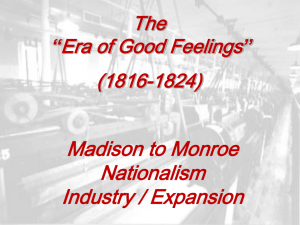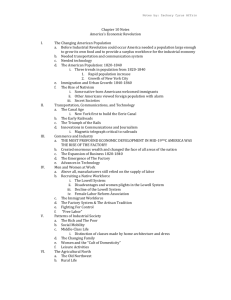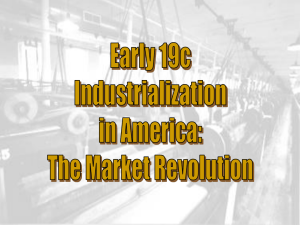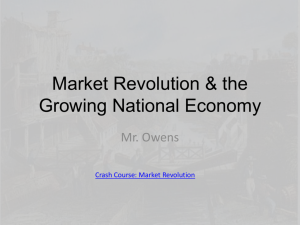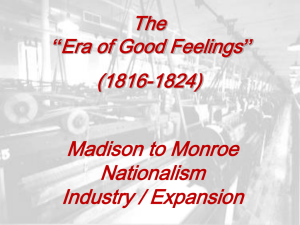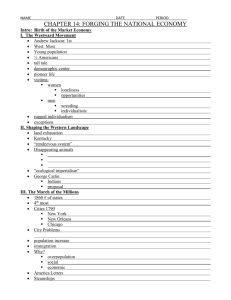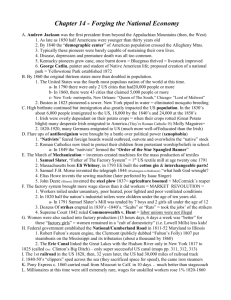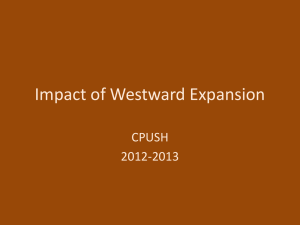early 19c Industrialization in America
advertisement
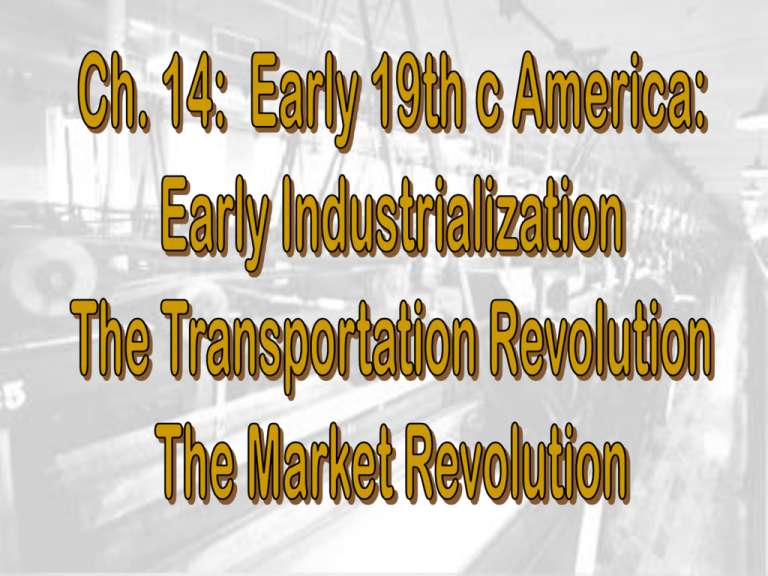
First Turnpike- 1790 Lancaster, PA By 1832, nearly 2400 mi. of road connected most major cities. Funded by states. Cumberland (National Road), 1811 Conestoga Covered Wagons Conestoga Trail, 1820s Robert Fulton & the Steamboat 1807: The Clermont STEAMBOATS • • • • NEW ORLEANS BECOMES MAJOR PORT MADE 2-WAY RIVER TRAFFIC PRACTICAL QUICKER THAN ROADS DISADVANTAGES: FREQUENT FIRES, COLLISIONS, ICE, SANDBARS CANALS •Even more efficient than roads for moving goods – lower costs & less time •Locks regulated the water level •Encouraged growth of cities & towns •State funding •Disadvantages: freeze in winter, dry up in summer Erie Canal – “Clinton’s Big Ditch” From Buffalo to Albany Begun 1817 & completed by 1825 Economic effects? Principal Canals in 1840 Inland Freight Rates RAILROADS • MOST PRACTICAL METHOD OF TRANSPORTATION SLOWER TO TAKE HOLD BECAUSE STATES SPENDING MORE $ ON ROADS & CANALS – POSSIBLE IN ALL KINDS OF WEATHER – ANY KIND OF TERRAIN – FASTEST • VERY DANGEROUS! – HIGH SPEEDS – FIRES & COLLISIONS – BAD BRAKES The “Iron Horse” Wins! (1830) 1830 13 miles of track built by Baltimore & Ohio RR By 1850 9000 mi. of RR track [1860 31,000 mi.] The Railroad Revolution, 1850s Immigrant labor built the Northern RRs. Slave labor built the Southern RRs. Stagecoaches The Pony Express • Stagecoaches traveled from MO River to California – Calling “shotgun?” • Pony Express, 1860 – Carried mail 2000 miles from MO to CA – Stations 10 miles apart – Could make it in 10 days! – Brought to an end by? Clipper Ships Why short-lived? Cyrus Field & the Transatlantic Cable, 1858 From Newfoundland to Ireland American Population Centers in 1820 Population doubling every 22 years American Population Centers in 1860 National Origin of Immigrants: 1820 - 1860 THE IRISH: • • • • 1840s; Largest group of immigrants 1845 potato famine in Ireland Very poor; Catholic; lots of whiskey Stayed in North & were in direct competition with free blacks for jobs – worked in factories (over 50% of mill labor force by 1860) but . . . “NINA?” – many go into police work – built canals, RRs GERMANS: • 1850s; 2nd largest group • Many come to escape political persecution (failed democratic revolutions of 1848) • wealthier than Irish; Catholic • settle in Midwest -- Wisconsin, etc. • form their own militia, fire companies, schools, newspapers, etc. • Not as politically influential as Irish – WHY? • Levi Strauss; Henrich Steinway • American cultural changes from the Germans? KnowNothing Party: “The Supreme Order of the Star-Spangled Banner” NATIVISM: • Prejudice against foreigners (threats to jobs) • 1844 rioting between Catholics & Protestants - over 100 injured • Samuel Morse – wrote against Catholics • Order of the Star Spangled Banner - Know-Nothings, form in 1849 – secret, anti-immigrant society – wanted to keep immigrants out of political office, restrict immigration & increase naturalization period to 21 years – later become a viable political party • Note: prejudice existed even among the immigrant groups themselves (Irish disliked blacks for ex.) WESTWARD WE GO! • Americans continually on the move West! • Greatest lure was the cheap, fertile land available • Farmers from South, farmers from Northeast & immigrants from Europe all came West • Rapidly growing towns sprang up along rivers where cargo was transferred – Cincinnati (“Queen City”), Louisville & Nashville • New farming inventions aided the move west: John Deere & the Steel Plow (1837) Cyrus McCormick & the Mechanical Reaper: 1831 1 man could do the work of 5 men with a sickle New technology/cash crop farming/leads to more debt The Factory System • Spreads from BR to US – slowly • Northeast – Industry is King! – – – – Bad soil Lots of labor Ports Rivers for Power! Creating a Business-Friendly Climate Supreme Court Rulings: * Fletcher v. Peck (1810) * Dartmouth v. Woodward (1819) * McCulloch v. Maryland (1819) * Gibbons v. Ogden (1824) * Charles Rivers Bridge v. Warren Bridge (1835) General Incorporation Law - passed by many states, such as NY, by 1848 (could incorporate without a state charter) Laissez faire - BUT, government did do much to assist capitalism! Samuel Slater (“Father of the Factory System”) Helps break BR monopoly in textiles First American mill – Providence, RI 1791 Effects? Industrial economy wellestablished in N Slater’s mill & Whitney’s cotton gin stimulate cotton economy & slave labor system Eli Whitney’s Cotton Gin, 1791 Actually invented by a slave? Eli Whitney’s Cotton Gin, 1791 Actually invented by a slave? Eli Whitney’s Gun Factory Interchangeable Parts Rifle So, how did Eli Whitney help bring on the Civil War AND help the North to win the war? What impact did the Embargo & NonIntercourse Acts and the War of 1812 have on the Industrial/Market Revolution? • Capital ($) and labor that were involved in commerce move into manufacturing • Nationalism and necessity spurred the production of American goods • After the War, BR dumped cheap manufactured goods on U.S. – this led to the use of protective tariffs Samuel F. B. Morse 1840 – Telegraph Telegraph brings an end to….? Wash., D.C. to Baltimore – 40 miles “What hath God wrought?” Elias Howe & Isaac Singer 1840s Sewing Machine Women now going to factories to sew, rather than at home. The Lowell/Waltham System Mass Production of Cotton Cloth Francis Cabot Lowell’s town - 1814 Lowell in 1850 Lowell Mill Early Textile Loom New England Textile Centers: 1830s New England Dominance in Textiles Lowell Girls What was their typical “profile?” Lowell Boarding Houses What was boardinghouse life like? Lowell Mills Time Table Early “Union” Newsletter I’m a Factory Girl Filled with Wishes I'm a factory girl Everyday filled with fear From breathing in the poison air Wishing for windows! I'm a factory girl Tired from the 13 hours of work each day And we have such low pay Wishing for shorten work times! I'm a factory girl Never having enough time to eat Nor to rest my feet Wishing for more free time! I'm a factory girl Sick of all this harsh conditions Making me want to sign the petition! So do what I ask for because I am a factory girl And I'm hereby speaking for all the rest! Irish Immigrant Girls at Lowell The Early Union Movement Workingman’s Party (1829) * Founded by Robert Dale Owen and others in New York City. Early unions were usually local, social, and weak. Commonwealth v. Hunt (1842) – didn’t legalize strikes but held that labor unions were NOT illegal conspiracies. Regional Specialization in America by the 1850s But….what connections? • NORTHEAST Industrial made textiles & machines for S & W • SOUTH Cotton & Slavery shipped to NE & BR • WEST Breadbasket of Nation fed factory workers in NE & Europe Changing Occupation Distributions: 1820 - 1860 MARKET REVOLUTION HAS TAKEN HOLD!! Subsistence economy of scattered farms & tiny workshops has been transformed into a national network of industry and commerce. Distribution of Wealth v v v v During the American Revolution, 45% of all wealth in the top 10% of the population. 1845 Boston - top 4% owned over 65% of the wealth. 1860 Philadelphia - top 1% owned over 50% of the wealth. The gap between rich and poor was widening! SOCIAL DEVELOPMENTS • Factory system & growth of cities undermined family as unit of economic production • Few women actually selfsupporting. Jobs in: – Nursing, domestic service – Teaching! Becomes totally feminized largely due to Catherine Beecher • Home becomes place of refuge rather than center of economic production • “Separate spheres” becomes new doctrine – “Cult of domesticity” • Decline in birthrate - family becomes smaller & more childcentered CULT OF DOMESTICITY & TRUE WOMANHOOD • Separate spheres: men off to work to support family, woman’s place is in the home • Popularized in newspapers, magazines, etc. • What were the 4 parts of ideal womanhood? • Why were women seen as physically inferior to men? • Why were women seen as intellectually inferior to men? • What strange myths arose as a result? ALEXIS de TOCQUEVILLE • French; came to study American prisons – Studies natives - 1831 – Belief that Europe is moving to democracy • “Democracy in America,” 1835 – Focuses on equality of conditions in US – Notes whole society seems to have turned into one middle class
